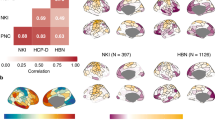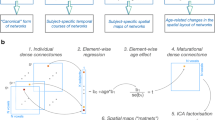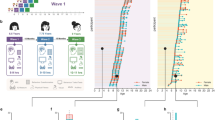Abstract
Animal studies of neurodevelopment have shown that recordings of intrinsic cortical activity evolve from synchronized and high amplitude to sparse and low amplitude as plasticity declines and the cortex matures. Leveraging resting-state functional MRI (fMRI) data from 1,033 youths (ages 8–23 years), we find that this stereotyped refinement of intrinsic activity occurs during human development and provides evidence for a cortical gradient of neurodevelopmental change. Declines in the amplitude of intrinsic fMRI activity were initiated heterochronously across regions and were coupled to the maturation of intracortical myelin, a developmental plasticity regulator. Spatiotemporal variability in regional developmental trajectories was organized along a hierarchical, sensorimotor–association cortical axis from ages 8 to 18. The sensorimotor–association axis furthermore captured variation in associations between youths’ neighborhood environments and intrinsic fMRI activity; associations suggest that the effects of environmental disadvantage on the maturing brain diverge most across this axis during midadolescence. These results uncover a hierarchical neurodevelopmental axis and offer insight into the progression of cortical plasticity in humans.
This is a preview of subscription content, access via your institution
Access options
Access Nature and 54 other Nature Portfolio journals
Get Nature+, our best-value online-access subscription
$29.99 / 30 days
cancel any time
Subscribe to this journal
Receive 12 print issues and online access
$209.00 per year
only $17.42 per issue
Buy this article
- Purchase on Springer Link
- Instant access to full article PDF
Prices may be subject to local taxes which are calculated during checkout






Similar content being viewed by others
Data availability
The current study analyzes an existing, publicly available dataset from the Philadelphia Neurodevelopmental Cohort, available in the Database of Genotypes and Phenotypes (phs000607.v3.p2). Study analyses additionally made use of publicly available cortical atlases, including the HCP-MMP atlas (downloaded from https://github.com/PennLINC/xcp_d/blob/main/xcp_d/data/ciftiatlas/glasser_space-fsLR_den-32k_desc-atlas.dlabel.nii), the Schaefer-400 atlas (downloaded from https://github.com/PennLINC/xcp_d/blob/main/xcp_d/data/ciftiatlas/Schaefer2018_400Parcels_17Networks_order.dlabel.nii) and the S–A axis (downloaded from https://pennlinc.github.io/S-A_ArchetypalAxis/). Data derivatives from the current study, including development effect and environment effect maps, are available for download from https://doi.org/10.5281/zenodo.7606653.
Code availability
Neuroimaging data were processed with containerized software packages available on dockerhub. Resting-state fMRI data were processed with fMRIPrep 20.2.3 (https://hub.docker.com/r/nipreps/fmriprep/tags) and xcp_d 0.0.4 (https://hub.docker.com/r/pennlinc/xcp_abcd/tags). Following image processing, all subsequent analyses and statistics were conducted in R 4.0.2 (https://www.r-project.org) using original analysis code and Connectome Workbench 1.5.0 tools (https://www.humanconnectome.org/software/get-connectome-workbench). Original code, including code used to calculate regional fluctuation amplitude, fit regional GAMs, contextualize developmental and environmental effects and perform sensitivity analyses, has been deposited at Zenodo and is available at https://doi.org/10.5281/zenodo.7606653. A detailed description of the code and guide to code implementation is additionally provided at https://pennlinc.github.io/spatiotemp_dev_plasticity/.
References
Sydnor, V. J. & Satterthwaite, T. D. Neuroimaging of plasticity mechanisms in the human brain: from critical periods to psychiatric conditions. Neuropsychopharmacology 48, 219–220 (2023).
Cooper, E. A. & Mackey, A. P. Sensory and cognitive plasticity: implications for academic interventions. Curr. Opin. Behav. Sci. 10, 21–27 (2016).
Sisk, L. M. & Gee, D. G. Stress and adolescence: vulnerability and opportunity during a sensitive window of development. Curr. Opin. Psychol. 44, 286–292 (2022).
Sydnor, V. J. et al. Neurodevelopment of the association cortices: patterns, mechanisms, and implications for psychopathology. Neuron 109, 2820–2846 (2021).
Bethlehem, R. A. I. et al. Brain charts for the human lifespan. Nature 604, 525–533 (2022).
Gogtay, N. et al. Dynamic mapping of human cortical development during childhood through early adulthood. Proc. Natl Acad. Sci. USA 101, 8174–8179 (2004).
Dong, H.-M., Margulies, D. S., Zuo, X.-N. & Holmes, A. J. Shifting gradients of macroscale cortical organization mark the transition from childhood to adolescence. Proc. Natl Acad. Sci. USA 118, e2024448118 (2021).
Grydeland, H. et al. Waves of maturation and senescence in micro-structural mri markers of human cortical myelination over the lifespan. Cereb. Cortex 29, 1369–1381 (2019).
Paquola, C. et al. Shifts in myeloarchitecture characterise adolescent development of cortical gradients. eLife 8, e50482 (2019).
Huttenlocher, P. R. & Dabholkar, A. S. Regional differences in synaptogenesis in human cerebral cortex. J. Comp. Neurol. 387, 167–178 (1997).
Larsen, B. & Luna, B. Adolescence as a neurobiological critical period for the development of higher-order cognition. Neurosci. Biobehav. Rev. 94, 179–195 (2018).
García-Cabezas, M. Á., Zikopoulos, B. & Barbas, H. The structural model: a theory linking connections, plasticity, pathology, development and evolution of the cerebral cortex. Brain Struct. Funct. 224, 985–1008 (2019).
Huntenburg, J. M., Bazin, P.-L. & Margulies, D. S. Large-scale gradients in human cortical organization. Trends Cogn. Sci. 22, 21–31 (2018).
Margulies, D. S. et al. Situating the default-mode network along a principal gradient of macroscale cortical organization. Proc. Natl Acad. Sci. USA 113, 12574–12579 (2016).
Hilgetag, C. C., Goulas, A. & Changeux, J.-P. A natural cortical axis connecting the outside and inside of the human brain. Netw. Neurosci. 6, 950–959 (2022).
Reh, R. K. et al. Critical period regulation across multiple timescales. Proc. Natl Acad. Sci. USA 117, 23242–23251 (2020).
Lensjø, K. K., Lepperød, M. E., Dick, G., Hafting, T. & Fyhn, M. Removal of perineuronal nets unlocks juvenile plasticity through network mechanisms of decreased inhibition and increased gamma activity. J. Neurosci. 37, 1269–1283 (2017).
Martini, F. J., Guillamón-Vivancos, T., Moreno-Juan, V., Valdeolmillos, M. & López-Bendito, G. Spontaneous activity in developing thalamic and cortical sensory networks. Neuron 109, 2519–2534 (2021).
Frye, C. G. & MacLean, J. N. Spontaneous activations follow a common developmental course across primary sensory areas in mouse neocortex. J. Neurophysiol. 116, 431–437 (2016).
Golshani, P. et al. Internally mediated developmental desynchronization of neocortical network activity. J. Neurosci. 29, 10890–10899 (2009).
Nakazawa, S., Yoshimura, Y., Takagi, M., Mizuno, H. & Iwasato, T. Developmental phase transitions in spatial organization of spontaneous activity in postnatal barrel cortex layer 4. J. Neurosci. 40, 7637–7650 (2020).
Toyoizumi, T. et al. A theory of the transition to critical period plasticity: inhibition selectively suppresses spontaneous activity. Neuron 80, 51–63 (2013).
Chini, M., Pfeffer, T. & Hanganu-Opatz, I. An increase of inhibition drives the developmental decorrelation of neural activity. eLife 11, e78811 (2022).
Fagiolini, M. & Hensch, T. K. Inhibitory threshold for critical-period activation in primary visual cortex. Nature 404, 183–186 (2000).
McGee, A. W., Yang, Y., Fischer, Q. S., Daw, N. W. & Strittmatter, S. M. Experience-driven plasticity of visual cortex limited by myelin and Nogo receptor. Science 309, 2222–2226 (2005).
Laumann, T. O. & Snyder, A. Z. Brain activity is not only for thinking. Curr. Opin. Behav. Sci. 40, 130–136 (2021).
Luhmann, H. J. et al. Spontaneous neuronal activity in developing neocortical networks: from single cells to large-scale interactions. Front. Neural Circuits 10, 40 (2016).
Lake, E. M. R. et al. Simultaneous cortex-wide fluorescence Ca2+ imaging and whole-brain fMRI. Nat. Methods 17, 1262–1271 (2020).
Ma, Z., Zhang, Q., Tu, W. & Zhang, N. Gaining insight into the neural basis of resting-state fMRI signal. NeuroImage 250, 118960 (2022).
Magri, C., Schridde, U., Murayama, Y., Panzeri, S. & Logothetis, N. K. The amplitude and timing of the BOLD signal reflects the relationship between local field potential power at different frequencies. J. Neurosci. 32, 1395–1407 (2012).
Shmuel, A. & Leopold, D. A. Neuronal correlates of spontaneous fluctuations in fMRI signals in monkey visual cortex: implications for functional connectivity at rest. Hum. Brain Mapp. 29, 751–761 (2008).
Yu-Feng, Z. et al. Altered baseline brain activity in children with ADHD revealed by resting-state functional MRI. Brain Dev. 29, 83–91 (2007).
Fair, D. A. & Yeo, B. T. T. Precision neuroimaging opens a new chapter of neuroplasticity experimentation. Neuron 107, 401–403 (2020).
Markicevic, M. et al. Cortical excitation:inhibition imbalance causes abnormal brain network dynamics as observed in neurodevelopmental disorders. Cereb. Cortex 30, 4922–4937 (2020).
Newbold, D. J. et al. Plasticity and spontaneous activity pulses in disused human brain circuits. Neuron 107, 580–589 (2020).
Hinton, E. A., Li, D. C., Allen, A. G. & Gourley, S. L. Social isolation in adolescence disrupts cortical development and goal-dependent decision-making in adulthood, despite social reintegration. eNeuro 6, ENEURO.0318-19.2019 (2019).
Greifzu, F. et al. Environmental enrichment extends ocular dominance plasticity into adulthood and protects from stroke-induced impairments of plasticity. Proc. Natl Acad. Sci. USA 111, 1150–1155 (2014).
Favuzzi, E. et al. Activity-dependent gating of parvalbumin interneuron function by the perineuronal net protein brevican. Neuron 95, 639–655 (2017).
Tooley, U. A., Bassett, D. S. & Mackey, A. P. Environmental influences on the pace of brain development. Nat. Rev. Neurosci. 22, 372–384 (2021).
Colich, N. L., Rosen, M. L., Williams, E. S. & McLaughlin, K. A. Biological aging in childhood and adolescence following experiences of threat and deprivation: a systematic review and meta-analysis. Psychol. Bull. 146, 721–764 (2020).
McDermott, C. L. et al. Early life stress is associated with earlier emergence of permanent molars. Proc. Natl Acad. Sci. USA 118, e2105304118 (2021).
Baum, G. L. et al. Graded variation in T1w/T2w ratio during adolescence: measurement, caveats, and implications for development of cortical myelin. J. Neurosci. 42, 5681–5694 (2022).
de Faria, O. et al. Periods of synchronized myelin changes shape brain function and plasticity. Nat. Neurosci. 24, 1508–1521 (2021).
Kato, D. et al. Motor learning requires myelination to reduce asynchrony and spontaneity in neural activity. Glia 68, 193–210 (2020).
Burt, J. B. et al. Hierarchy of transcriptomic specialization across human cortex captured by structural neuroimaging topography. Nat. Neurosci. 21, 1251–1259 (2018).
Hill, J. et al. Similar patterns of cortical expansion during human development and evolution. Proc. Natl Acad. Sci. USA 107, 13135–13140 (2010).
Moore, T. M. et al. Characterizing social environment’s association with neurocognition using census and crime data linked to the Philadelphia Neurodevelopmental Cohort. Psychol. Med. 46, 599–610 (2016).
Tooley, U. A. et al. Associations between neighborhood SES and functional brain network development. Cereb. Cortex 30, 1–19 (2020).
O’Leary, D. D. M., Chou, S.-J. & Sahara, S. Area patterning of the mammalian cortex. Neuron 56, 252–269 (2007).
Charvet, C. J. & Finlay, B. L. Evo-devo and the primate isocortex: the central organizing role of intrinsic gradients of neurogenesis. Brain Behav. Evol. 84, 81–92 (2014).
Ackman, J. B., Burbridge, T. J. & Crair, M. C. Retinal waves coordinate patterned activity throughout the developing visual system. Nature 490, 219–225 (2012).
Benders, M. J. et al. Early brain activity relates to subsequent brain growth in premature infants. Cereb. Cortex 25, 3014–3024 (2015).
Winnubst, J., Cheyne, J. E., Niculescu, D. & Lohmann, C. Spontaneous activity drives local synaptic plasticity in vivo. Neuron 87, 399–410 (2015).
Takesian, A. E. & Hensch, T. K. in Progress in Brain Research, Vol. 207 (eds. Merzenich, M. M., Nahum, M. & Van Vleet, T. M.) Ch. 1 (Elsevier, 2013).
Carulli, D. et al. Animals lacking link protein have attenuated perineuronal nets and persistent plasticity. Brain 133, 2331–2347 (2010).
Anderson, K. M. et al. Transcriptional and imaging-genetic association of cortical interneurons, brain function, and schizophrenia risk. Nat. Commun. 11, 2889 (2020).
Micheva, K. D. et al. A large fraction of neocortical myelin ensheathes axons of local inhibitory neurons. eLife 5, e15784 (2016).
Condé, F., Lund, J. S. & Lewis, D. A. The hierarchical development of monkey visual cortical regions as revealed by the maturation of parvalbumin-immunoreactive neurons. Brain Res. Dev. Brain Res. 96, 261–276 (1996).
Benoit, L. J. et al. Adolescent thalamic inhibition leads to long-lasting impairments in prefrontal cortex function. Nat. Neurosci. 25, 714–725 (2022).
Acevedo-Garcia, D. et al. Racial and ethnic inequities in children’s neighborhoods: evidence from the new child opportunity index 2.0. Health Aff. 39, 1693–1701 (2020).
Norbom, L. B. et al. Parental socioeconomic status is linked to cortical microstructure and language abilities in children and adolescents. Dev. Cogn. Neurosci. 56, 101132 (2022).
Piekarski, D. J., Boivin, J. R. & Wilbrecht, L. Ovarian hormones organize the maturation of inhibitory neurotransmission in the frontal cortex at puberty onset in female mice. Curr. Biol. 27, 1735–1745 (2017).
Kobayashi, Y., Ye, Z. & Hensch, T. K. Clock genes control cortical critical period timing. Neuron 86, 264–275 (2015).
Konstantinides, N. et al. A complete temporal transcription factor series in the fly visual system. Nature 604, 316–322 (2022).
Nielsen, A. N. et al. Maturation of large-scale brain systems over the first month of life. Cereb. Cortex https://doi.org/10.1093/cercor/bhac242 (2022).
Satterthwaite, T. D. et al. Neuroimaging of the Philadelphia Neurodevelopmental Cohort. NeuroImage 86, 544–553 (2014).
Esteban, O. et al. fMRIPrep: a robust preprocessing pipeline for functional MRI. Nat. Methods 16, 111–116 (2019).
Avants, B. B. et al. A reproducible evaluation of ANTs similarity metric performance in brain image registration. NeuroImage 54, 2033–2044 (2011).
Dale, A. M., Fischl, B. & Sereno, M. I. Cortical surface-based analysis. I. Segmentation and surface reconstruction. NeuroImage 9, 179–194 (1999).
Ciric, R. et al. Benchmarking of participant-level confound regression strategies for the control of motion artifact in studies of functional connectivity. NeuroImage 154, 174–187 (2017).
Ciric, R. et al. Mitigating head motion artifact in functional connectivity MRI. Nat. Protoc. 13, 2801–2826 (2018).
Glasser, M. F. et al. A multi-modal parcellation of human cerebral cortex. Nature 536, 171–178 (2016).
Schaefer, A. et al. Local–global parcellation of the human cerebral cortex from intrinsic functional connectivity MRI. Cereb. Cortex 28, 3095–3114 (2018).
Pham, D. D., Muschelli, J. & Mejia, A. F. ciftiTools: a package for reading, writing, visualizing, and manipulating CIFTI files in R. NeuroImage 250, 118877 (2022).
Cui, Z. et al. Individual variation in functional topography of association networks in Youth. Neuron 106, 340–353 (2020).
Covitz, S. et al. Curation of BIDS (CuBIDS): a workflow and software package for streamlining reproducible curation of large BIDS datasets. NeuroImage 263, 119609 (2022).
Wood, S. N. Generalized Additive Models: An Introduction with R (Chapman and Hall/CRC, 2017).
Simpson, G. L. Modelling palaeoecological time series using generalised additive models. Front. Ecol. Evol. 6, 149 (2018).
Satterthwaite, T. D. et al. Impact of puberty on the evolution of cerebral perfusion during adolescence. Proc. Natl Acad. Sci. USA 111, 8643–8648 (2014).
Reardon, P. K. et al. Normative brain size variation and brain shape diversity in humans. Science 360, 1222–1227 (2018).
Vaishnavi, S. N. et al. Regional aerobic glycolysis in the human brain. Proc. Natl Acad. Sci. USA 107, 17757–17762 (2010).
Yarkoni, T., Poldrack, R. A., Nichols, T. E., Van Essen, D. C. & Wager, T. D. Large-scale automated synthesis of human functional neuroimaging data. Nat. Methods 8, 665–670 (2011).
Paquola, C. et al. The BigBrainWarp toolbox for integration of BigBrain 3D histology with multimodal neuroimaging. eLife 10, e70119 (2021).
Diedenhofen, B. & Musch, J. cocor: a comprehensive solution for the statistical comparison of correlations. PLoS ONE 10, e0121945 (2015).
Garrett, D. D., Lindenberger, U., Hoge, R. D. & Gauthier, C. J. Age differences in brain signal variability are robust to multiple vascular controls. Sci. Rep. 7, 10149 (2017).
Adebimpe, A. et al. ASLPrep: a platform for processing of arterial spin labeled MRI and quantification of regional brain perfusion. Nat. Methods 19, 683–686 (2022).
Alexander-Bloch, A. F. et al. On testing for spatial correspondence between maps of human brain structure and function. NeuroImage 178, 540–551 (2018).
Váša, F. et al. Adolescent tuning of association cortex in human structural brain networks. Cereb. Cortex 28, 281–294 (2018).
Acknowledgements
This study was supported by grants from the National Institute of Health: R01MH113550 to T.D.S. and D.S.B., R01MH120482 to T.D.S., R01MH112847 to R.T.S. and T.D.S., R01MH119219 to R.C.G. and R.E.G., R01MH123563 to R.T.S., R01MH119185 to D.R.R., R01MH120174 to D.R.R., R01NS060910 to R.T.S., R01EB022573 to T.D.S., RF1MH116920 to T.D.S. and D.S.B., RF1MH121867 to T.D.S., R37MH125829 to T.D.S., R34DA050297 to A.P.M., K08MH120564 to A.F.A.-B., K99MH127293 to B.L. and T32MH014654 to J.S. V.J.S. was supported by a National Science Foundation Graduate Research Fellowship (DGE-1845298). The Philadelphia Neurodevelopmental Cohort was supported by RC2 grants MH089983 and MH089924. Additional support was provided by the Penn-CHOP Lifespan Brain Institute and the Penn Center for Biomedical Image Computing and Analytics.
Author information
Authors and Affiliations
Contributions
V.J.S. conceived the neurodevelopmental framework and designed the study with B.L. and T.D.S. R.E.G., R.C.G. and T.D.S. provided resources and supervised collection of the neuroimaging data. D.R.R. and T.D.S. curated and quality checked the neuroimaging data. V.J.S., A.A., M.A.B., M.C. and S.C. processed the neuroimaging data with software tools developed by A.A., M.C. and S.C. V.J.S. implemented all statistical analyses with R code written by V.J.S. and B.L. A.F.A.-B. and R.T.S. provided input on statistical approaches. D.S.B. and Y.F. provided input on image analytic approaches. B.L. conducted an internal code review and technical replication of all study findings. J.S. provided data used to derive the S–A axis. T.M.M. generated the neighborhood environment factor scores, and A.P.M. provided expert guidance on environmental analyses. V.J.S. generated all figures. V.J.S. wrote the original draft and all authors (V.J.S., B.L., J.S., A.A., A.F.A.-B., D.S.B., M.A.B., M.C., S.C., Y.F., R.E.G., R.C.G., A.P.M., T.M.M., D.R.R., R.T.S. and T.D.S.) reviewed and revised the final draft.
Corresponding author
Ethics declarations
Competing interests
The authors declare the following competing interest: R.T.S. receives consulting income from Octave Bioscience for work wholly unrelated to the present research. All other authors declare no competing interests.
Peer review
Peer review information
Nature Neuroscience thanks Natalie Brito, Lucina Uddin, and the other, anonymous, reviewer(s) for their contribution to the peer review of this work.
Additional information
Publisher’s note Springer Nature remains neutral with regard to jurisdictional claims in published maps and institutional affiliations.
Supplementary information
Rights and permissions
Springer Nature or its licensor (e.g. a society or other partner) holds exclusive rights to this article under a publishing agreement with the author(s) or other rightsholder(s); author self-archiving of the accepted manuscript version of this article is solely governed by the terms of such publishing agreement and applicable law.
About this article
Cite this article
Sydnor, V.J., Larsen, B., Seidlitz, J. et al. Intrinsic activity development unfolds along a sensorimotor–association cortical axis in youth. Nat Neurosci 26, 638–649 (2023). https://doi.org/10.1038/s41593-023-01282-y
Received:
Accepted:
Published:
Issue Date:
DOI: https://doi.org/10.1038/s41593-023-01282-y
This article is cited by
-
Functional connectivity development along the sensorimotor-association axis enhances the cortical hierarchy
Nature Communications (2024)
-
Personalized functional brain network topography is associated with individual differences in youth cognition
Nature Communications (2023)



